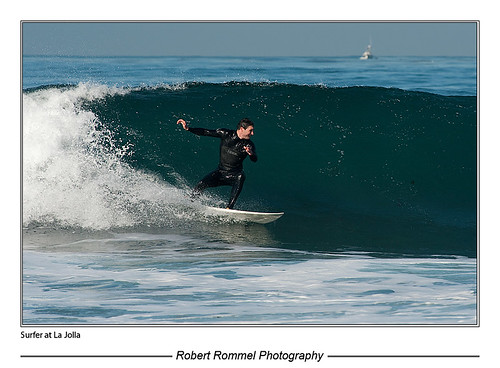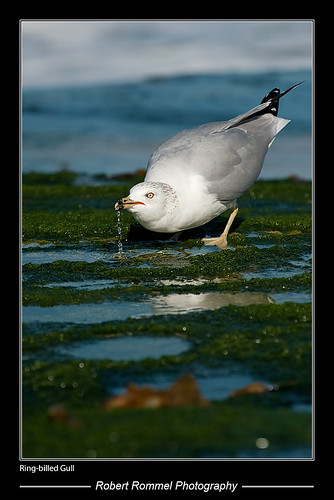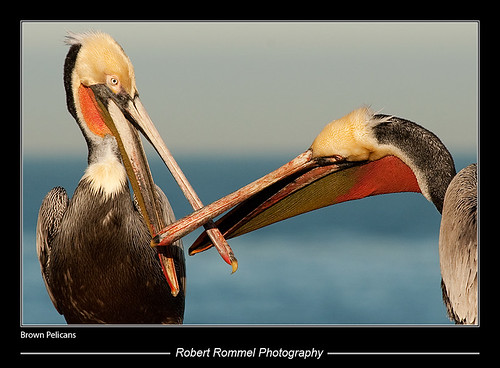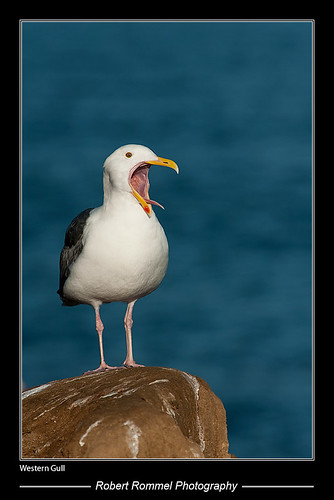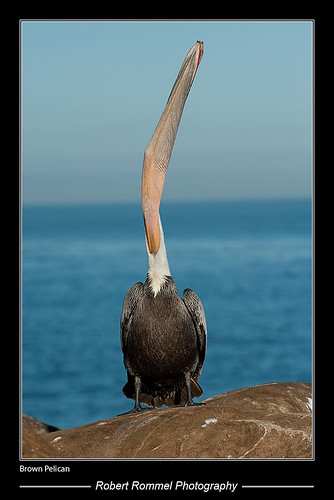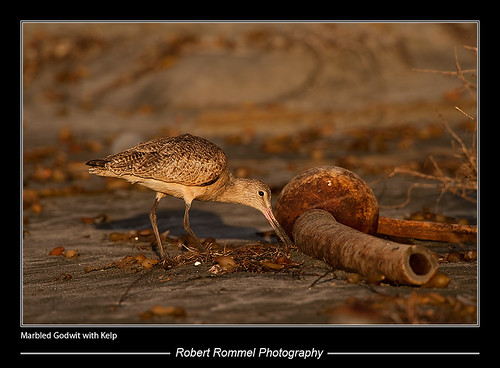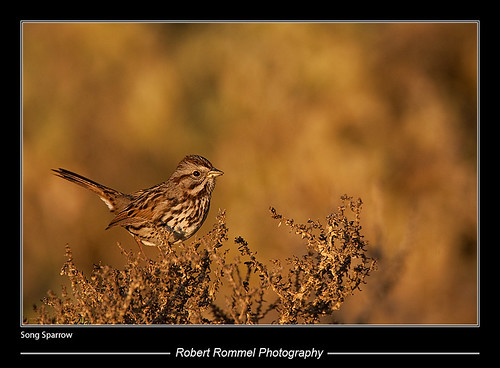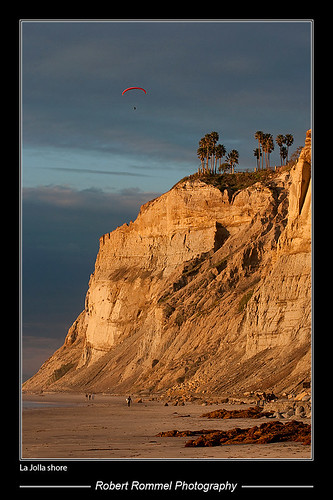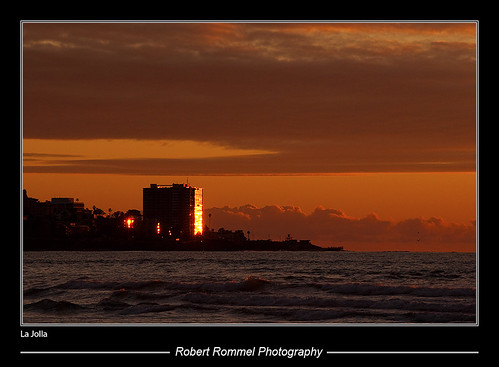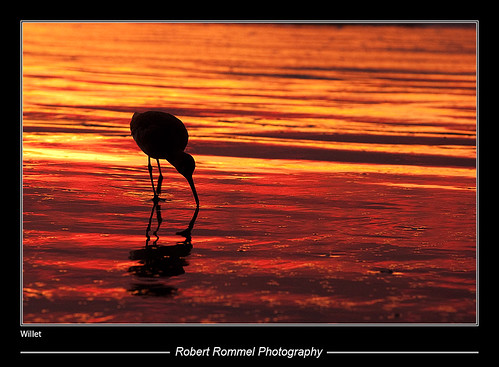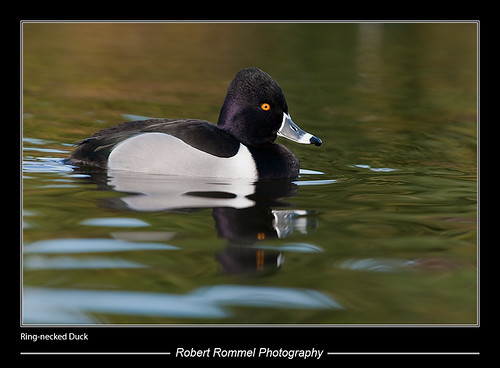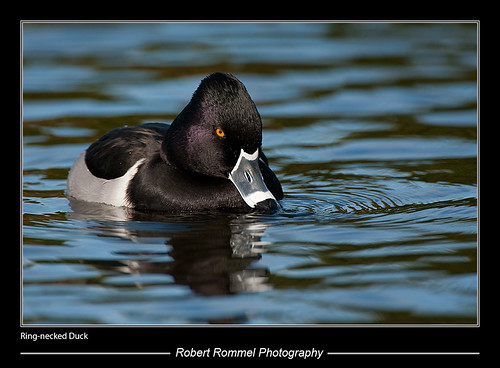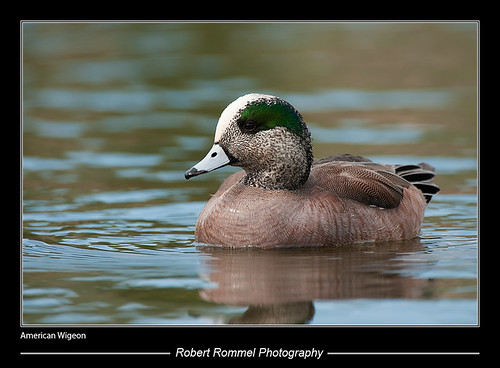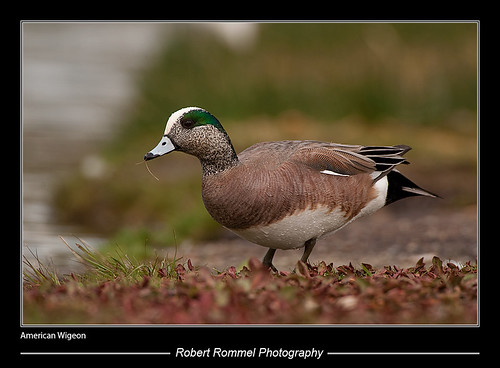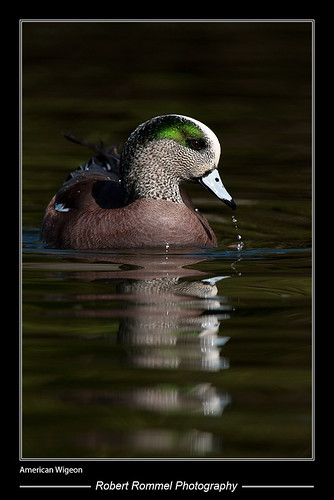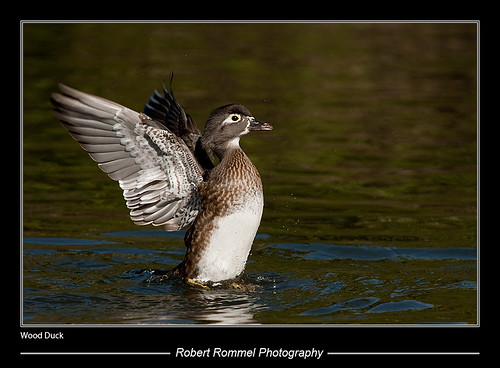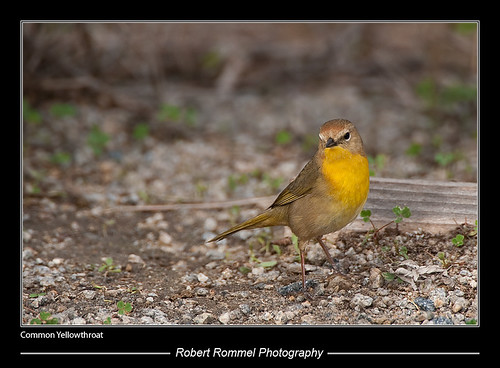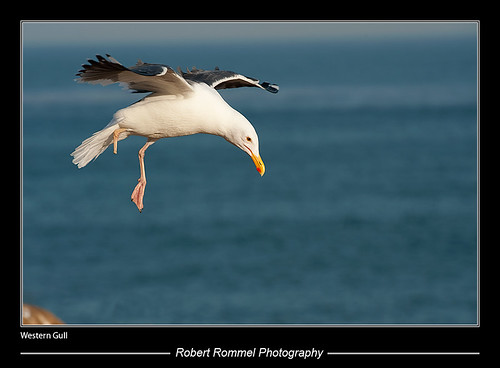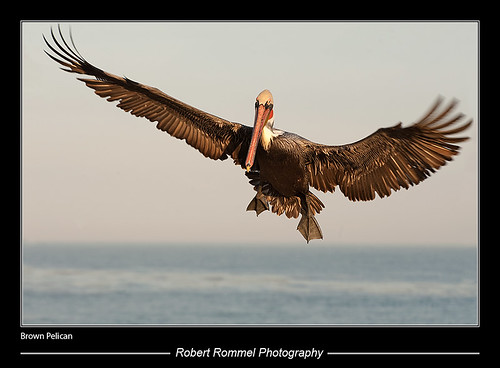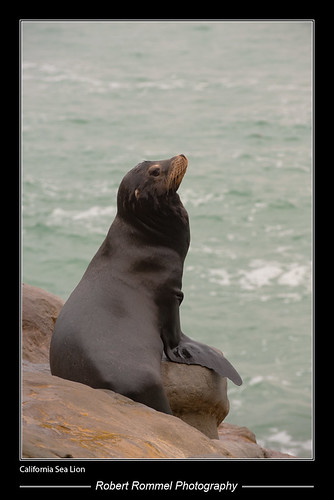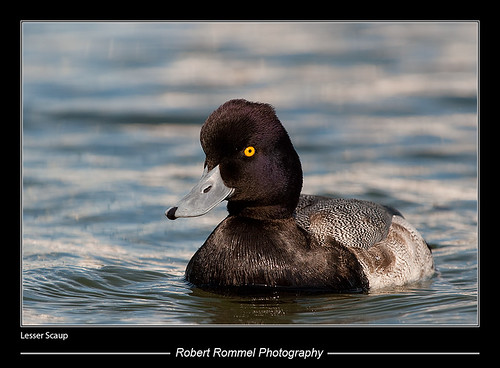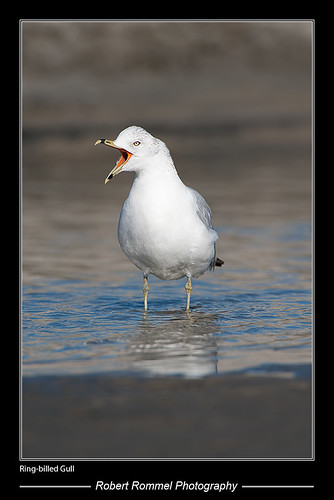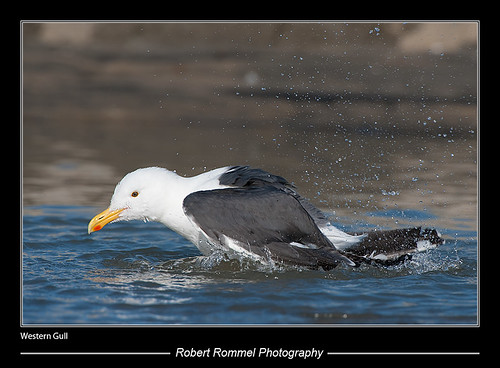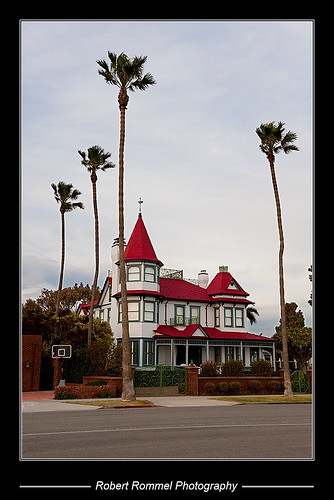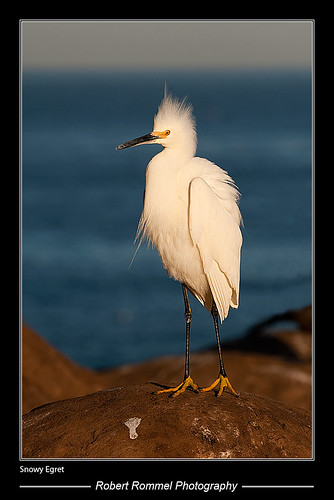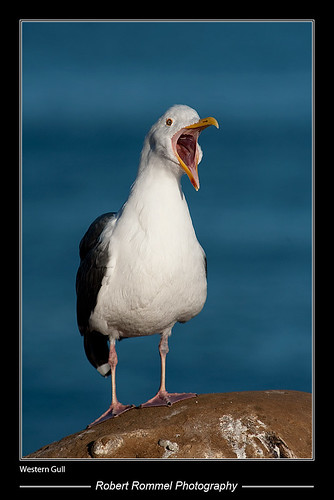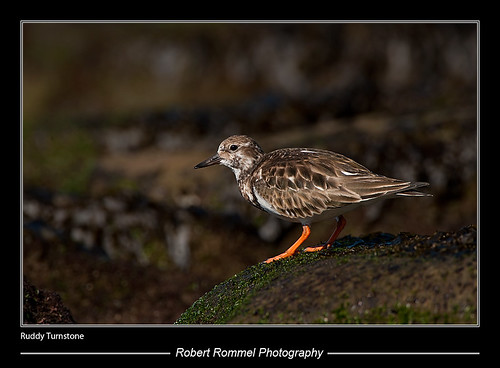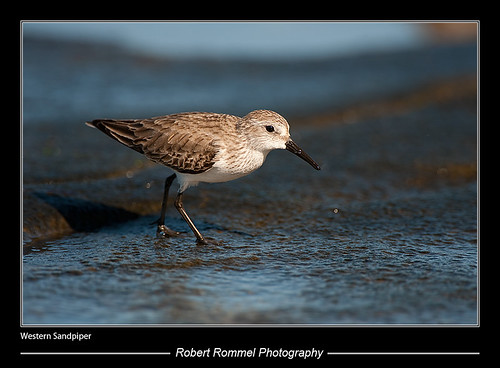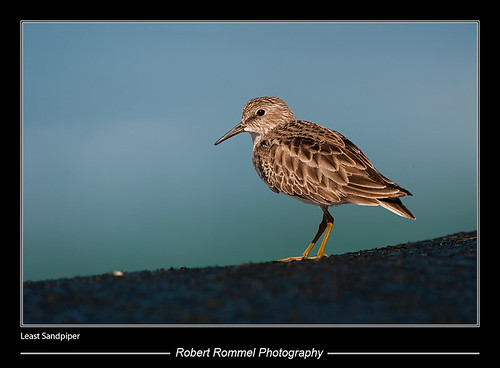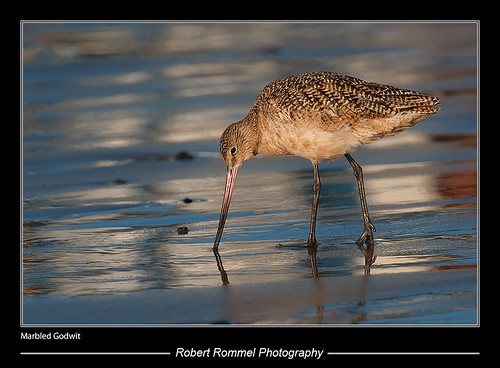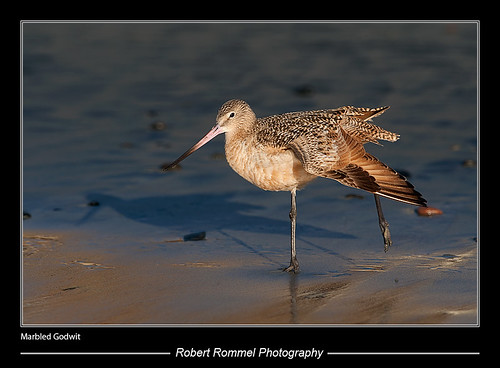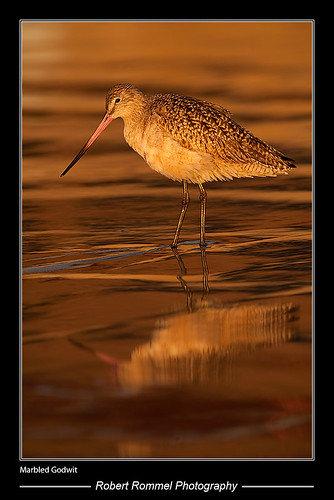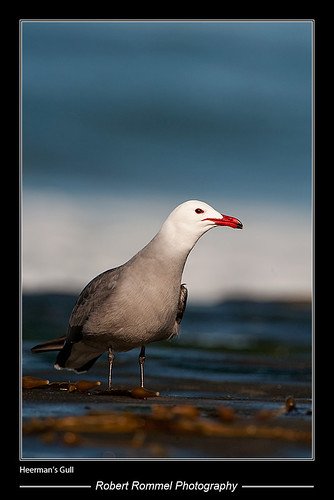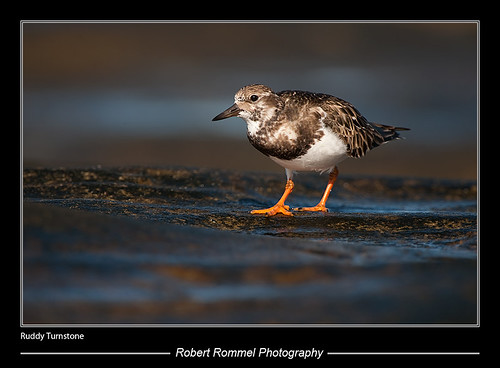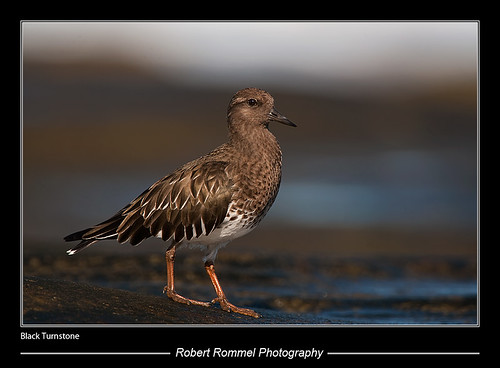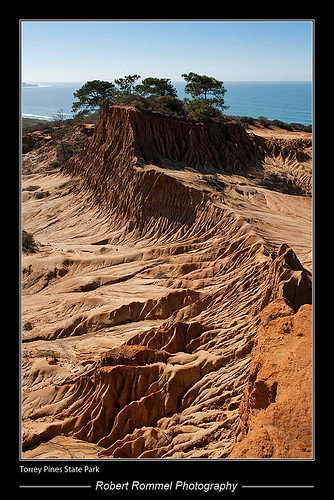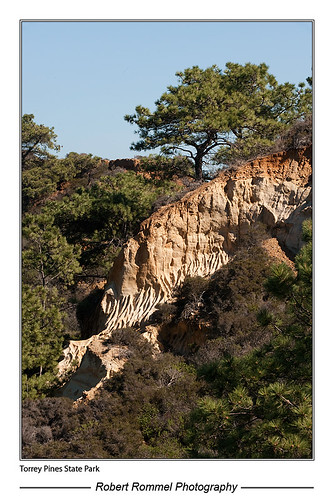(January 28th) After a couple of hours on the cliffs, I checked out other spots of the La Jolla shore. Most of it was pretty dead though, but I found some rather unexpected subjects. I took a change of pace for an hour or so and for the first time photographed some surfing. According to the surfers I had missed the best waves, but I still had fun.
Near where I was seated there were some tide pools coated with seaweed. They turned out to be a favorite drinking spot for a few gulls. I had brought just the 70-200mm lens to shoot the surfers, but luckily the gulls came very close. I loved the color of the green seaweed. The plumage on this Ring-billed Gull was great too. Combined with the drinking, it made for some great shots.
Some Western Gulls joined the fray. The immature gulls had long left the nest and been raised, but they still are a bit lazy. They haven't given up the notion that adult birds might feed them. This one kept pestering this adult until finally it ran away further down the rocks.
After the gull diversion, it was back to the surfers. The waves were getting further out and a little smaller but I shot a few more pictures before calling it a day. Just like with wildlife, the more you watch them, the more you can predict what the surfers will do. They are a lot easier to pan with though.
Just as I was getting ready to leave, a Heerman's Gull came to the pools to drink as well. The Heerman's waited for the Ring-billed to finish its business and then helped itself when all was clear. Such a striking gull - the green of the seaweed complemented its beak and plumage nicely. Gulls have no problem drinking the salt water that we cannot.
Saturday, April 3, 2010
Behavior Makes It Special
(January 28th) Over the last several days, I had been seeing some amazing things. Part of it is just the animals, but even more so was the things they do. Behavior is one of the trickiest things to capture. You have to anticipate it and even then you have to be fast to catch it. Also, you have to try and capture the essence of what the animal is doing is just one click. I had plenty of portraits over the last few days, but today much of my focus was on capturing the rarer behaviors. This shot catches a Western Gull taking off. Normally I am opposed to clipping wings, but it works for me in this image.
When the Brown Pelicans land on the cliffs, they land in the midst of a bunch of other pelicans. Usually they push the others aside to clear some room, but sometimes the pelicans have more complicated behaviors. One of the rarer things they do is to lock bills with each other. I've heard that the current theory is this is display of friendship rather than negative feelings. It doesn't last very long so you have to be ready for it.
The Western Gulls seem to love to hang around the pelicans. Sometimes they will fly away to find a quick morsel of food. But they come back quickly and there is a hierarchy for which gull deserves the best spot. This individual is coming in for a landing.
Life on the cliff is rarely quiet. Although the pelicans and cormorants don't vocalize much, the gulls make up for it. And I love tongues, so there was no way I was going to miss this photo. That red spot on the gull's beak - chicks will tap at that spot for their parents to feed them.
I've watched Brown Pelicans many times on the east coast, but I've always seen lone birds or small flocks of less than a dozen. Here on the cliffs large groups come together and you see behaviors that you don't see in the smaller groups. One behavior that I've never seen before has a few names including a 'head throw'. It's another one of those behaviors that you see it for a second and then the bird is done. Why exactly they do this behavior isn't clear - one thought is that it is to communicate to others.
When the Brown Pelicans land on the cliffs, they land in the midst of a bunch of other pelicans. Usually they push the others aside to clear some room, but sometimes the pelicans have more complicated behaviors. One of the rarer things they do is to lock bills with each other. I've heard that the current theory is this is display of friendship rather than negative feelings. It doesn't last very long so you have to be ready for it.
The Western Gulls seem to love to hang around the pelicans. Sometimes they will fly away to find a quick morsel of food. But they come back quickly and there is a hierarchy for which gull deserves the best spot. This individual is coming in for a landing.
Life on the cliff is rarely quiet. Although the pelicans and cormorants don't vocalize much, the gulls make up for it. And I love tongues, so there was no way I was going to miss this photo. That red spot on the gull's beak - chicks will tap at that spot for their parents to feed them.
I've watched Brown Pelicans many times on the east coast, but I've always seen lone birds or small flocks of less than a dozen. Here on the cliffs large groups come together and you see behaviors that you don't see in the smaller groups. One behavior that I've never seen before has a few names including a 'head throw'. It's another one of those behaviors that you see it for a second and then the bird is done. Why exactly they do this behavior isn't clear - one thought is that it is to communicate to others.
Thursday, March 11, 2010
Evening Sunset
(January 27th) After a very long morning with the ducks, it was time to head to the shore. Getting access to the shore where I wanted was much harder than I had thought. I kept going down side streets, but none of them had access to the ocean through the cliffs. Finally I talked with a local resident and was pointed to the one street that I didn't try and walked down through the cliffs. As I walked the length of the beach, it seemed I was out of luck - no birds anywhere. The drought lifted at a rocky outcropping where I found a Spotted Sandpiper.
The beach didn't have much in the way of birds, but there were a couple of Willets hanging around. I was treated to a little bit of behavior unexpectedly and was able to snag a few shots. Although they had the whole beach to themselves, one of the Willets decided to chase the other away. Who knows why it wanted that one spot so much.
As the sun approached the horizon, a third shorebird showed up at the beach. A Marbled Godwit landed a few hundred yards away from me. Most shorebirds make there way down to the shoreline to forage, but this godwit headed up to line of debris. It busied itself sorting through the kelp and finding morsels mixed in. The kelp on the Pacific shore is quite amazing. Huge pieces of seaweed frequently wash up, something you never see on the Atlantic shore.
While photographing the godwit, I heard a call from the brush at the edge of the beach. After a while I was able to locate the source. A Song Sparrow was perched atop some vegetation. This was yet another bird that I've seen many other places, but the plumage in southern California is distinctly different from what I am used to - in this case the markings are much bolder and the rufous patches more prominent.
In wildlife photography the perception is that you are out someplace remote, surrounded by gorgeous scenery. Much of the time this isn't true and part of the challenge is to make the environment look its best. But down at the shore here, it certainly wasn't the case. The surroundings truly were gorgeous and while the animals kept me busy most of the time, occasionally I did stop to marvel at it. To further add to things, there was a place atop the cliffs where paragliders were taking off from and flying overhead in the stiff air currents.
As I glanced across the water, the sunset was lighting up the town of La Jolla. Most of the buildings in La Jolla are relatively small, but there is one large building. Frotunately this building has a glass front adding some drama to the scene.
The sunset was magnificent, but I loved most was following the three shorebirds I had around during the sunset. The shore turned to glass that burned richly. I was very pleased with the way the shots turned out and had many successful images with only these three subjects. One of my favorites was this photo of one of the Willets. I think the photos were worth the embarassment and discomfort of lying down in the wet sand and getting drenched. It was a wonderful end to an amazing afternoon of photography.
The beach didn't have much in the way of birds, but there were a couple of Willets hanging around. I was treated to a little bit of behavior unexpectedly and was able to snag a few shots. Although they had the whole beach to themselves, one of the Willets decided to chase the other away. Who knows why it wanted that one spot so much.
As the sun approached the horizon, a third shorebird showed up at the beach. A Marbled Godwit landed a few hundred yards away from me. Most shorebirds make there way down to the shoreline to forage, but this godwit headed up to line of debris. It busied itself sorting through the kelp and finding morsels mixed in. The kelp on the Pacific shore is quite amazing. Huge pieces of seaweed frequently wash up, something you never see on the Atlantic shore.
While photographing the godwit, I heard a call from the brush at the edge of the beach. After a while I was able to locate the source. A Song Sparrow was perched atop some vegetation. This was yet another bird that I've seen many other places, but the plumage in southern California is distinctly different from what I am used to - in this case the markings are much bolder and the rufous patches more prominent.
In wildlife photography the perception is that you are out someplace remote, surrounded by gorgeous scenery. Much of the time this isn't true and part of the challenge is to make the environment look its best. But down at the shore here, it certainly wasn't the case. The surroundings truly were gorgeous and while the animals kept me busy most of the time, occasionally I did stop to marvel at it. To further add to things, there was a place atop the cliffs where paragliders were taking off from and flying overhead in the stiff air currents.
As I glanced across the water, the sunset was lighting up the town of La Jolla. Most of the buildings in La Jolla are relatively small, but there is one large building. Frotunately this building has a glass front adding some drama to the scene.
The sunset was magnificent, but I loved most was following the three shorebirds I had around during the sunset. The shore turned to glass that burned richly. I was very pleased with the way the shots turned out and had many successful images with only these three subjects. One of my favorites was this photo of one of the Willets. I think the photos were worth the embarassment and discomfort of lying down in the wet sand and getting drenched. It was a wonderful end to an amazing afternoon of photography.
Tuesday, March 9, 2010
The Way the Wind Blows
(January 27th) It's become a bit of a routine now, waking up before dawn and driving up to the cliffs to spend time with the pelicans. When I got there everything was all wrong. The light was fine, and the pelicans were there. The big problem was the wind - it was blowing in the worst possible direction. If I was to use the light when the sun came up, I'd be getting a lot of photographs of the rear of pelicans. Head-on, from the side - these angles all are workable, but from the tail just isn't good. So I quickly got back in the car and drove another half an hour to get the duck location. After waiting around about an hour for the park to open, in I went and the ducks, like this Ring-necked Duck were waiting.
I had a lot of portrait shots from the last time here, so I was trying to work a few new things. I wanted some 'action' shots, and well... you just have to wait and hope. I found it comical when this Mallard rolled onto its side in the water and started to scratch itself.
While action was a goal, my primary motivation for the day was to apply some of the lessons I had learned from working the light at the shore three days earlier. The goal was to bring out some nice color in the water and work the light properly. Started out pretty simple with some more typical colors like in this Ring-necked Duck photograph.
Clouds came through and changed the light pretty dramatically and I moved around to a different lake. The lakes here had several duck species. While I spent a lot of time with the Ring-necked and Wood Ducks, there were a few of the less common ducks like this male American Wigeon that provided some great opportunities.
I was busy photographing the ducks in the water when the completely unexpected happened. One of the wigeons decided to walk right up out of the water, and right next to me. I'm lying completely down to make the birds at ease with me and also to get a good angle on the birds. It gave me some unusual shots of the American Wigeon I would never have guessed I would take before he walked too close to me to photograph.
The sun eventually emerged from the clouds and I moved back to the original concept and moved to a spot where I could work the color into the water. I was very pleased with the hues in a series of photographs of another wigeon. The water dribbling from his beak added an nice extra touch.
As always, there were many shots I missed. Most I just wasn't able to get the camera on in time and the shot by the time I did, and a few something was missing with my capture. Plenty did come out as I was imagining though. In a few that combination of light, color, composition, and subject all came together. I had a lot of action shots during the day, mostly of birds flapping. I've spent so much time showing off the males, that I thought I'd show this one of a female Wood Duck.
I had a lot of portrait shots from the last time here, so I was trying to work a few new things. I wanted some 'action' shots, and well... you just have to wait and hope. I found it comical when this Mallard rolled onto its side in the water and started to scratch itself.
While action was a goal, my primary motivation for the day was to apply some of the lessons I had learned from working the light at the shore three days earlier. The goal was to bring out some nice color in the water and work the light properly. Started out pretty simple with some more typical colors like in this Ring-necked Duck photograph.
Clouds came through and changed the light pretty dramatically and I moved around to a different lake. The lakes here had several duck species. While I spent a lot of time with the Ring-necked and Wood Ducks, there were a few of the less common ducks like this male American Wigeon that provided some great opportunities.
I was busy photographing the ducks in the water when the completely unexpected happened. One of the wigeons decided to walk right up out of the water, and right next to me. I'm lying completely down to make the birds at ease with me and also to get a good angle on the birds. It gave me some unusual shots of the American Wigeon I would never have guessed I would take before he walked too close to me to photograph.
The sun eventually emerged from the clouds and I moved back to the original concept and moved to a spot where I could work the color into the water. I was very pleased with the hues in a series of photographs of another wigeon. The water dribbling from his beak added an nice extra touch.
As always, there were many shots I missed. Most I just wasn't able to get the camera on in time and the shot by the time I did, and a few something was missing with my capture. Plenty did come out as I was imagining though. In a few that combination of light, color, composition, and subject all came together. I had a lot of action shots during the day, mostly of birds flapping. I've spent so much time showing off the males, that I thought I'd show this one of a female Wood Duck.
Wednesday, March 3, 2010
Lagoon
(January 26th) As it had turned into a cloudy day and I had many great days of photography so far and still a few days remaining, I took a calculated risk. In retrospect, I wish I had gone to photograph the ducks again - the cloudy conditions would have helped with the high range of contrast on these birds. But that was something I only learned after looking over the photos when I got back. My overall strategy for the San Diego trip was to spend my time at locations that would be good for photography - what I call high-percentage places. Today I headed to a location that I knew was great for bird watching, but I suspected would be tough for photographing. In truth it was a great place for wildlife, but as I suspected it was tough to shoot in. San Elijo Lagoon has a wide variety of habitat, but the animals in general were quite shy - or just shy enough to stay out of photographing range. That combined with the flat light left me few pictures.
My week was all-around fantastic, so having one afternoonthat was slow didn't bother me in the least. Instead I was able to watch some great behavior on lots of birds - Black Phoebes, House Finches, Lesser Goldfinches, Anna's Hummingbirds, California Towhees, etc. I learned about their habits just spending a few hours watching them even if I never got the opportunity to photograph much. On a decent day I would have deleted a picture like this one of a Common Yellowthroat. The background and head angle don't work for me. But the second half of today wasn't decent and I kept it - if for no other reason than that it reminds me that the coloration of the Common Yellowthroats down in Southern California is substantially more dramatic than the individuals we have back east. You only need one reason that makes sense to you to keep a photograph.
My week was all-around fantastic, so having one afternoonthat was slow didn't bother me in the least. Instead I was able to watch some great behavior on lots of birds - Black Phoebes, House Finches, Lesser Goldfinches, Anna's Hummingbirds, California Towhees, etc. I learned about their habits just spending a few hours watching them even if I never got the opportunity to photograph much. On a decent day I would have deleted a picture like this one of a Common Yellowthroat. The background and head angle don't work for me. But the second half of today wasn't decent and I kept it - if for no other reason than that it reminds me that the coloration of the Common Yellowthroats down in Southern California is substantially more dramatic than the individuals we have back east. You only need one reason that makes sense to you to keep a photograph.
An Attempt
(January 26th) Today I returned for a morning of shooting the pelicans, but with a modification. I had taken quite a few portraits shots and close-ups. I had also concentrated on some behavior as well. Today's game plan was to concentrate on flight shots. Since I've spent almost every morning at this location and not really given much of a feel for what it's like, here is a picture from across the water of the cliffs that the pelicans and cormorants come to in the morning. These are the rocks that I'm climbing all over, leaning out over, etc.
In the minutes before the sun comes up, there often aren't many pelicans there yet. But the cormorants sleep on the vertical faces of rock. This Brandt's Cormorant actually is in breeding plumage and these cool whiskers that I love, but they're tucked in as it sleeps. In this low light, your photographs can capture much of the detail that falls into shadow with just a little bit of direct light.
I forgot to mention that I suffered an equipment failure during this trip rather early on. My flash sync cord stopped working and an attempt to fix it failed miserably. Without this, I was flash-less which was something I wished to use many times during the trip. While I was focusing on flight, I was prepared to photograph anything that piqued my interest. This Brown Pelican had not only stretched out its head to scratch, but also turned its head completely upside down. If it was going to go through all those contortions, how could I not press the shutter?
One advantage of these cliffs is that many birds come to it. This is a double-edged sword though. It's great because there are lots of subjects in front of you. The disadvantage though is that it can be difficult to isolate a single bird and make clean compositions. Especially for flight shots, you have to time a single shot just right to get a bird in good light, good position, and positioned in the frame without distracting objects or other birds. This Western Gull intrigued me as its lack of a foot didn't hamper it from flying, landing, or even walking around. I wonder what story it would tell if it could describe how it lost its foot.
I got a few acceptable flight shots today, but I felt unsatisfied. I vowed to try again soon and improve on the shots. This one of a Brown Pelican coming in for a landing was definitely one of the better ones. I had a little bit of sunshine before most of the morning was dominated by dense cloud cover.
The pelicans didn't stick around very long in the morning, but they weren't the only ones using the cliffs. I climbed down near the base of the cliff (which is rather difficult when you're carrying one large camera and lens on a tripod and have another strapped around your neck - don't try this at home, kids...) to reach some of the other visitors. A few California Sea Lions had hauled up onto the rocks. This large male was looking out over the females which had come up to share his rock. He spared me a few glances but I didn't seem to interest him much.
In the minutes before the sun comes up, there often aren't many pelicans there yet. But the cormorants sleep on the vertical faces of rock. This Brandt's Cormorant actually is in breeding plumage and these cool whiskers that I love, but they're tucked in as it sleeps. In this low light, your photographs can capture much of the detail that falls into shadow with just a little bit of direct light.
I forgot to mention that I suffered an equipment failure during this trip rather early on. My flash sync cord stopped working and an attempt to fix it failed miserably. Without this, I was flash-less which was something I wished to use many times during the trip. While I was focusing on flight, I was prepared to photograph anything that piqued my interest. This Brown Pelican had not only stretched out its head to scratch, but also turned its head completely upside down. If it was going to go through all those contortions, how could I not press the shutter?
One advantage of these cliffs is that many birds come to it. This is a double-edged sword though. It's great because there are lots of subjects in front of you. The disadvantage though is that it can be difficult to isolate a single bird and make clean compositions. Especially for flight shots, you have to time a single shot just right to get a bird in good light, good position, and positioned in the frame without distracting objects or other birds. This Western Gull intrigued me as its lack of a foot didn't hamper it from flying, landing, or even walking around. I wonder what story it would tell if it could describe how it lost its foot.
I got a few acceptable flight shots today, but I felt unsatisfied. I vowed to try again soon and improve on the shots. This one of a Brown Pelican coming in for a landing was definitely one of the better ones. I had a little bit of sunshine before most of the morning was dominated by dense cloud cover.
The pelicans didn't stick around very long in the morning, but they weren't the only ones using the cliffs. I climbed down near the base of the cliff (which is rather difficult when you're carrying one large camera and lens on a tripod and have another strapped around your neck - don't try this at home, kids...) to reach some of the other visitors. A few California Sea Lions had hauled up onto the rocks. This large male was looking out over the females which had come up to share his rock. He spared me a few glances but I didn't seem to interest him much.
Friday, February 26, 2010
Water Birds
(January 25th) For the afternoon I headed down to two new locations known for being good for water birds. The first was a duck hangout. I wanted to go there because it is one of the best locations in the country to shoot Lesser Scaup. This particular species is often quite skittish or stays far from shore. Here if I just subjected myself to crouching on sharp rocks and slopping in thick mud, I could have a chance to get close. Sure enough, a sore bottom later, I came out with quite a few shots of this great species. In this shot, a male is swimming right at me at close range.
There were about twenty or so scaup that swam near me. The females were mixed in with the males. Although they lack the metallic sheen and some of the contrasting colors of the males, for female duck species they are quite attractive. Scaup are diving ducks like the Ring-necked Ducks I was shooting the other day. They would dive searching for food and periodically spend a bit of time preening. This female has just emerged from a dive and you can see how the water just beads up on their feathers keeping them dry.
I was in for a treat when a pair of Redheads showed up to check out what the scaup were doing. Some birds can be very brave and others very shy. Some species tend to be braver than others, but differences exist within a species too. Birds that are accustomed to human contact are often considerably braver than species that rarely encounter humans. But sometimes you just can't explain why some are shy and others are brave. That was the case with this pair of Redheads. The male started to approach and gave me time for all of 2 shutter clicks before he decided to turn back and go away. The female on the other hand had no reservations and came within a couple of feet of me and stayed until I left. No idea why the two were so different, but here's one of the shots of the male.
I wrapped up with the ducks and headed to the beach. Gulls were the order of business for the end of the day. There was a small pool of water near the beach that gulls just loved. At the banks of this pool one Ring-billed Gull was all worked up. It made sure to let everyone known that something was on its mind.
The pool itself was actively being used by the gulls. They were drinking from it and bathing in it (gulls can drink seawater). The bathing was quite comical so I had a great time watching them at it. This Western Gull was paddling away in the pool splashing every which way. Just like the ducks, gulls rarely seem to get wet.
I had a great time with the gulls in the pool, but what I had come there for was flight shots. I had a strategy in mind, and it turned out to be a bit flawed. In retrospect, it would have worked great if either I had a third arm or had brought someone else along. So I didn't have great luck with the flight shots, but this is one of a pair of Heerman's gulls that I liked. You probably can't tell in the small size of the posted version, but the foreground gull is drooling.
The light started to leave me and it was time to head home. There were some amazing houses and hotels around the location. I don't think I'll ever be able to afford a home there or even staying in the plush hotels, but I did take a picture of one of the houses I liked the most. I had to rush out into a busy street between cars to get the angle I wanted - if only I could have moved the basketball hoop out of the shot.
There were about twenty or so scaup that swam near me. The females were mixed in with the males. Although they lack the metallic sheen and some of the contrasting colors of the males, for female duck species they are quite attractive. Scaup are diving ducks like the Ring-necked Ducks I was shooting the other day. They would dive searching for food and periodically spend a bit of time preening. This female has just emerged from a dive and you can see how the water just beads up on their feathers keeping them dry.
I was in for a treat when a pair of Redheads showed up to check out what the scaup were doing. Some birds can be very brave and others very shy. Some species tend to be braver than others, but differences exist within a species too. Birds that are accustomed to human contact are often considerably braver than species that rarely encounter humans. But sometimes you just can't explain why some are shy and others are brave. That was the case with this pair of Redheads. The male started to approach and gave me time for all of 2 shutter clicks before he decided to turn back and go away. The female on the other hand had no reservations and came within a couple of feet of me and stayed until I left. No idea why the two were so different, but here's one of the shots of the male.
I wrapped up with the ducks and headed to the beach. Gulls were the order of business for the end of the day. There was a small pool of water near the beach that gulls just loved. At the banks of this pool one Ring-billed Gull was all worked up. It made sure to let everyone known that something was on its mind.
The pool itself was actively being used by the gulls. They were drinking from it and bathing in it (gulls can drink seawater). The bathing was quite comical so I had a great time watching them at it. This Western Gull was paddling away in the pool splashing every which way. Just like the ducks, gulls rarely seem to get wet.
I had a great time with the gulls in the pool, but what I had come there for was flight shots. I had a strategy in mind, and it turned out to be a bit flawed. In retrospect, it would have worked great if either I had a third arm or had brought someone else along. So I didn't have great luck with the flight shots, but this is one of a pair of Heerman's gulls that I liked. You probably can't tell in the small size of the posted version, but the foreground gull is drooling.
The light started to leave me and it was time to head home. There were some amazing houses and hotels around the location. I don't think I'll ever be able to afford a home there or even staying in the plush hotels, but I did take a picture of one of the houses I liked the most. I had to rush out into a busy street between cars to get the angle I wanted - if only I could have moved the basketball hoop out of the shot.
Wednesday, February 24, 2010
Plans Need To Be Flexible
(January 25th) When I go out shooting, I always have a plan and a few goals in mind. For this San Diego trip, I had well thought out plans, and was fine-tuning up constantly as I got word of the weather and wind conditions or learned more. This morning I headed to the cliffs again to photograph the Brown Pelicans. Well I took a few pictures of the pelicans, but not many. They were there alright, but there were a few unexpected surprises that had me adjusting my plans. One of which was a pair of Snowy Egrets that showed up. Now I'm used to photographing these birds in the water, but on top of a cliff that overlooks rough surf? Very unexpected, but all the more reason to concentrate on it. It didn't hurt either that the egrets possessed full breeding plumage and this one showed off its crown.
After a while, the egrets chased each other off. Still I didn't go back to the pelicans. There were a group of gulls that were quite raucous. Good behavior, good light, what more can you want? It's amazing how wide they can get that mouth open. Had some shots dead on, but I prefer the ones like this where you get some eye contact.
After the cliffs, I headed down to the place I had seen the turnstones yesterday. Sure enough they were there. Also there was the first Surfbird for me. It was a great sight, but like most first, no photos came of it. The turnstones gave me some fantastic poses though. One of my favorites was this one of a Ruddy Turnstone with the composition and angle.
I walked further up the shore past where the turnstones were and found myself on the edge of a large rock that formed a small cliff to the water. Up here there were a few small shorebirds. One of the advantages of being in a place like this is that no one else in their right mind will climb out onto the rocky ledge, so you don't have to worry about anyone except yourself scaring the birds. At first they were a bit cautious, but they warmed up and approached me. Eventually they too close to focus. These little guys are among the smallest birds you'll see so getting close is a necessity when you're using a 400mm and full-frame camera like I have. Here's one of the Western Sandpipers on the rocks.
I think the best shots of the morning came when I was able to catch the shorebirds right against the edge of the ledge. Then the background depended on the wave action - either being the blue of the water, or the white of a wave, or an ugly combination of both if you didn't time the shot right. Being so close, it made this Least Sandpiper pop out and the over-the-shoulder pose shows off the coverts of its wing.
After a while, the egrets chased each other off. Still I didn't go back to the pelicans. There were a group of gulls that were quite raucous. Good behavior, good light, what more can you want? It's amazing how wide they can get that mouth open. Had some shots dead on, but I prefer the ones like this where you get some eye contact.
After the cliffs, I headed down to the place I had seen the turnstones yesterday. Sure enough they were there. Also there was the first Surfbird for me. It was a great sight, but like most first, no photos came of it. The turnstones gave me some fantastic poses though. One of my favorites was this one of a Ruddy Turnstone with the composition and angle.
I walked further up the shore past where the turnstones were and found myself on the edge of a large rock that formed a small cliff to the water. Up here there were a few small shorebirds. One of the advantages of being in a place like this is that no one else in their right mind will climb out onto the rocky ledge, so you don't have to worry about anyone except yourself scaring the birds. At first they were a bit cautious, but they warmed up and approached me. Eventually they too close to focus. These little guys are among the smallest birds you'll see so getting close is a necessity when you're using a 400mm and full-frame camera like I have. Here's one of the Western Sandpipers on the rocks.
I think the best shots of the morning came when I was able to catch the shorebirds right against the edge of the ledge. Then the background depended on the wave action - either being the blue of the water, or the white of a wave, or an ugly combination of both if you didn't time the shot right. Being so close, it made this Least Sandpiper pop out and the over-the-shoulder pose shows off the coverts of its wing.
Monday, February 22, 2010
So That's How It's Done
(January 24th) Sometimes you see something in a photograph and you can't figure out just how they did that. Water was one of those things I never fully understood how to photograph. I'd seen pictures that some photographers have where the water is all sorts of unbelievable colors and wished I could do something like that. I imagined that they had to be there in the most amazing sunset to get something like that. Anyway, the gameplan for this afternoon was to try and use the water in a new way. I started out and ran into one of my favorite subjects to shoot, Marbled Godwits. Fantastic bird to shoot, and I started off with some nice, clean shots.
The godwits were as cooperative as I could hope for. They ignored me completely and kept about there business. At first they spent most of the time sleeping but as time rolled on they began to forage. I was standing ankle deep in water to shoot from the water side. The waves drenched my pants, but luckily the camera remained dry. The godwits rewarded me with a wing stretch to show off their patterned markings.
As I worked the godwits and they moved down the beach, I started to understand how water works and how to create the images I was looking for. At first it was subtle. The water in this photograph has taken on a different hue, but it's relatively mild. I could start to feel the magic starting to happen and knew I was on to something.
At this point, I had one of the a-ha moments. Something that should have been so easy, but I just couldn't figure it out before. You just have to do it to learn it. I shot this Willet who was near the group of godwits. By this time, I had the color working full swing. It was one of those clicks that you didn't need to look at the photos later that night. You just know it worked out as you wanted.
The color kept blazing away and I had a blast shooting the godwits. Here's one of the Marbled Godwits in the color at its fullest. I learned that there is magic in these photographs all right. But it's not post-processing - this color is as I saw it. The magic as always is in harnessing the light.
I was happy working every last drop of light as I wondered if my pants would be salvageable. As I lost any direct light, it was time to shoot the only thing possible - silhouettes. Yeah I know it's rare, but sometimes I photograph people too. It was one of those classic images as the last die-hard surfers left the water as the sun went down. It may be a little cheesey, but I had to make that click.
The godwits were as cooperative as I could hope for. They ignored me completely and kept about there business. At first they spent most of the time sleeping but as time rolled on they began to forage. I was standing ankle deep in water to shoot from the water side. The waves drenched my pants, but luckily the camera remained dry. The godwits rewarded me with a wing stretch to show off their patterned markings.
As I worked the godwits and they moved down the beach, I started to understand how water works and how to create the images I was looking for. At first it was subtle. The water in this photograph has taken on a different hue, but it's relatively mild. I could start to feel the magic starting to happen and knew I was on to something.
At this point, I had one of the a-ha moments. Something that should have been so easy, but I just couldn't figure it out before. You just have to do it to learn it. I shot this Willet who was near the group of godwits. By this time, I had the color working full swing. It was one of those clicks that you didn't need to look at the photos later that night. You just know it worked out as you wanted.
The color kept blazing away and I had a blast shooting the godwits. Here's one of the Marbled Godwits in the color at its fullest. I learned that there is magic in these photographs all right. But it's not post-processing - this color is as I saw it. The magic as always is in harnessing the light.
I was happy working every last drop of light as I wondered if my pants would be salvageable. As I lost any direct light, it was time to shoot the only thing possible - silhouettes. Yeah I know it's rare, but sometimes I photograph people too. It was one of those classic images as the last die-hard surfers left the water as the sun went down. It may be a little cheesey, but I had to make that click.
Sunday, February 21, 2010
Jam-Packed Morning
(January 24th) Today I had some full plans. My list of places to photograph at in San Diego was extensive and I wanted to have enough time to return to the best locations. Since I hadn't even been to many of the locations, I was planning on going to a few places today. Early morning I started out with the Brown Pelicans again. They were as cooperative as ever. This time I was already cueing in on some of their behavior. They have this really cool behavior they perform here on the cliffs that I have never seen pelicans do before. But the background was less than perfect on these shots, so I'll be trying again for that shot on future mornings. With the great light, the portraits of these stunning animals came out well. Unfortunately the spray of water from its beak doesn't quite come out at the small size here.
I didn't spend too long with the pelicans, but headed down to a rocky section of the shore. What drew me to the location was a group of my favorite gull species, the Heerman's Gull. They were resting on the rocks. Between the rocks, the waves, and the kelp, I really liked the backgrounds for the shots. My pants got quite wet though lying down on the rocks, but I was fortunate that no waves caught me.
With wildlife, patience always pays rewards. Ok, not always, but you certainly get nowhere by rushing. As I worked the gulls, a few extra visitors showed up. A pair of Ruddy Turnstone scoured the rocks looking for food. I had photographed these birds before in Florida and Ohio, but always against sandy shores. It was great to see them on some rocky shores. Next time I see some, I hope I can get them in breeding plumage.
Last year I had visited a different part of California's coast. On that trip I saw a few Black Turnstones, but they were always on distant rocks too far off shore to do much with. This time I was treated to some up close and personal. They don't have as much color as their Ruddy cousins, but their wings show the same scaled look. I felt lucky to get so many great photos of this great bird on only my second time seeing them. It doesn't usually happen that way!
As midday approached, it was time to find someplace else. I had heard about Torrey Pines State Park. There was supposed to be a good amount of wildlife there, but I had a feeling that it was going to be one of those places where there would be lots of wildlife, but all of it pretty shy and difficult conditions to photograph. But there were supposed to be great scenics. So the middle of the day seemed like the best time to give it a try. If it was great, I could come back when the light was better. At least I would get a nice walk in amongst some gorgeous scenery. Here are some of the cool rock formations that I saw at the beginning of my loop.
The scenery in Torrey Pines was fantastic. As I guessed, it was going to be near impossible to get any wildlife photography done there. The biggest barrier was that the trails were packed! It seemed like all of southern California flocks to this park to walk, run, picnic, etc. I don't think I went 30 seconds on a trail without someone else passing me. The place has a lot of steep hills. The climate gives it a mix of chaparral and lightly tree-covered areas. The rocks make for some nice lines in the scenery. If I had more time in San Diego or lived nearby, this was definitely a spot I would return to in better light to heavily work the scenery.
Torrey Pines is most famous for its namesake - a rare pine tree that only grows in this one area on the coast and on a small island off the coast. It's the rarest pine tree in the US and the second rarest in the world. There's only about 2000 of them total. Part of their rarety comes from slow growth that is restricted to sandy soil like at the reserve. I'm sure that the other part comes from human destruction of habitat, etc. One of the remarkable traits of these trees is that the wind shapes them into unusual shapes. Here was one individual that I photographed for a while from a myriad of angles and perspectives. This was my favorite composition by far - framing the smaller tree and capturing the amount of hill and ocean I wanted.
I didn't spend too long with the pelicans, but headed down to a rocky section of the shore. What drew me to the location was a group of my favorite gull species, the Heerman's Gull. They were resting on the rocks. Between the rocks, the waves, and the kelp, I really liked the backgrounds for the shots. My pants got quite wet though lying down on the rocks, but I was fortunate that no waves caught me.
With wildlife, patience always pays rewards. Ok, not always, but you certainly get nowhere by rushing. As I worked the gulls, a few extra visitors showed up. A pair of Ruddy Turnstone scoured the rocks looking for food. I had photographed these birds before in Florida and Ohio, but always against sandy shores. It was great to see them on some rocky shores. Next time I see some, I hope I can get them in breeding plumage.
Last year I had visited a different part of California's coast. On that trip I saw a few Black Turnstones, but they were always on distant rocks too far off shore to do much with. This time I was treated to some up close and personal. They don't have as much color as their Ruddy cousins, but their wings show the same scaled look. I felt lucky to get so many great photos of this great bird on only my second time seeing them. It doesn't usually happen that way!
As midday approached, it was time to find someplace else. I had heard about Torrey Pines State Park. There was supposed to be a good amount of wildlife there, but I had a feeling that it was going to be one of those places where there would be lots of wildlife, but all of it pretty shy and difficult conditions to photograph. But there were supposed to be great scenics. So the middle of the day seemed like the best time to give it a try. If it was great, I could come back when the light was better. At least I would get a nice walk in amongst some gorgeous scenery. Here are some of the cool rock formations that I saw at the beginning of my loop.
The scenery in Torrey Pines was fantastic. As I guessed, it was going to be near impossible to get any wildlife photography done there. The biggest barrier was that the trails were packed! It seemed like all of southern California flocks to this park to walk, run, picnic, etc. I don't think I went 30 seconds on a trail without someone else passing me. The place has a lot of steep hills. The climate gives it a mix of chaparral and lightly tree-covered areas. The rocks make for some nice lines in the scenery. If I had more time in San Diego or lived nearby, this was definitely a spot I would return to in better light to heavily work the scenery.
Torrey Pines is most famous for its namesake - a rare pine tree that only grows in this one area on the coast and on a small island off the coast. It's the rarest pine tree in the US and the second rarest in the world. There's only about 2000 of them total. Part of their rarety comes from slow growth that is restricted to sandy soil like at the reserve. I'm sure that the other part comes from human destruction of habitat, etc. One of the remarkable traits of these trees is that the wind shapes them into unusual shapes. Here was one individual that I photographed for a while from a myriad of angles and perspectives. This was my favorite composition by far - framing the smaller tree and capturing the amount of hill and ocean I wanted.
Subscribe to:
Posts (Atom)
